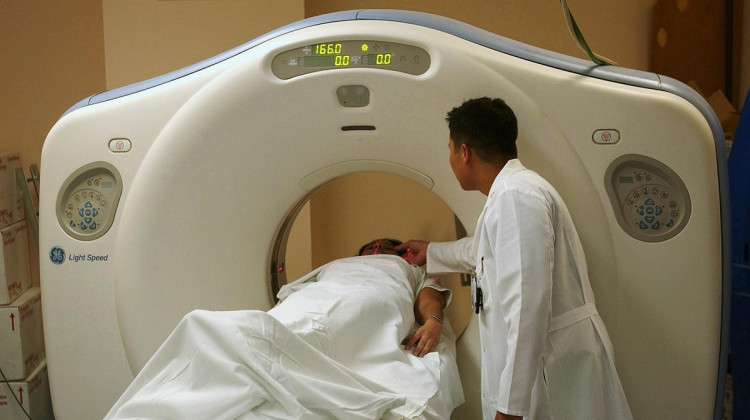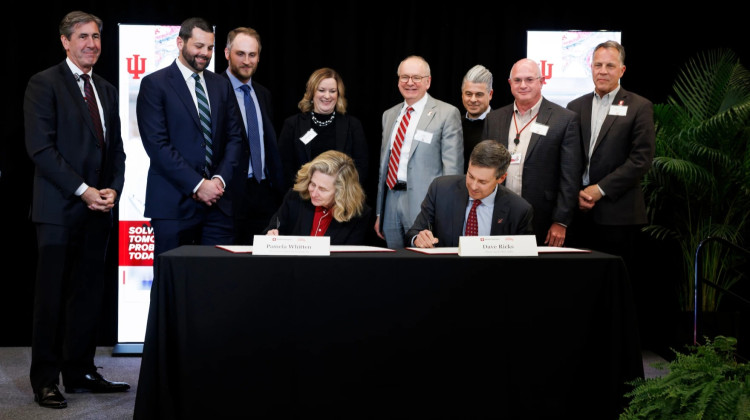
U.S. clinicians use a drug known as contrast media to perform an estimated 50 million scans every year. But right now, about half of the nation's hospitals are rationing the drug due to a critical shortage.
Bethesda Naval Medical Center / Pixabay
Dan Gorenstein, Andrea Perdomo – Tradeoffs
Updated June 21 at 10 a.m.
The U.S. is caught in a critical shortage of a drug known as contrast media that helps physicians diagnose conditions like a heart attack or stroke.
Doctors perform about 50 million scans a year using the injectable drug, which is also used for cancer patients and gunshot and car crash victims. It helps them see blood vessels and blockages so they can plan surgeries or determine a patient’s cancer stage.
But these days, about half of all U.S. hospitals are rationing the essential drug. GE Healthcare, one of the country’s two major contrast media producers, started limiting orders when a COVID-19 lockdown temporarily shut down production at one of its facilities in Shanghai this spring.
Contrast media is the latest example that the U.S. medical supply chain is fragile. Over the past two decades, more than 3,000 drugs have been in short supply in the U.S., often sending hospitals scrambling and putting patients at risk.
When Kierstin Kennedy, chief medical officer for University of Alabama at Birmingham Hospital, learned about the shortage, she called together staff from cardiology, neurosurgery, radiology and the emergency department to take stock of who was using how much.
GE told the hospital it would receive 20 percent of its normal shipment until production ramped back up. But the first shipment never showed, and the second had only a few bottles.
“That was the ‘holy crap’ moment for me,” Kennedy said. “We've asked people to reduce how much they're using, but maybe we didn't ask them to reduce it enough because at this rate, we're only going to get a couple of bottles a week.”
UAB’s comprehensive stroke center draws people from parts of Florida, Georgia, Mississippi and Tennessee, and contrast is critical to quickly diagnosing and treating stroke victims.
“We know that if we do this in a timely fashion, we could save brain tissue and function and keep them from being neurologically devastated,” Kennedy said. “But we may not be able to do it because we don't have contrast.”
The hospital rescheduled elective surgeries, postponed image tests and conserved enough contrast to get two uses out of one vial. They also limited the use of the drug in departments where it isn’t critical for providing care. These efforts cut use by 90 percent, which Kennedy hopes will stretch their supply through December.
While this kind of rationing may be lifesaving for a stroke victim, it means other patients have to go without contrast. As a result, Kennedy said clinicians have to do additional tests that can delay diagnosis and treatment, and potentially cost patients more money.
“That, to me, is not ideal and it's not what we want for our patients,” Kennedy said.
GE announced that production at its Shanghai factory is back up to 100 percent as of early June. It may take several weeks for the supply of contrast media to recover enough for hospitals, like UAB, to resume regular use of the drug.
Kennedy expressed shock that such a basic and necessary drug like contrast media could become scarce, but experts say numerous attempts to strengthen the country’s medical supply chain have come up short.
“We do not have a resilient supply chain at all,” said Erin Fox, senior pharmacy director at the University of Utah Health. “We rely on just-in-time manufacturing where companies only make just enough medication. There's no reserve on hand.”
With just-in-time manufacturing, companies can know exactly how much they need to make, cutting waste and improving their bottom line. But that leaves firms vulnerable to adjustments in care brought on by issues like a pandemic or natural disaster.
One factor lawmakers have attempted to address is requiring more information from manufacturers about potential shortages. In 2012, lawmakers required drugmakers to warn the Food and Drug Administration if they anticipate a shortage, and in 2020 Congress made companies share with the agency how long they think a shortage will last. Lawmakers also gave the FDA authority to ask companies to make contingency plans.
But despite those provisions, the U.S. continues to experience roughly 100 new drug shortages each year. Fox said even with the reporting requirements, the FDA lacks any enforcement power, so it’s still common for companies to keep quiet in the face of potential shortages.
Federal health officials estimate problems with quality — like metal shavings in a drug vial — drive 62 percent of shortages. Fox said hospitals negotiating contracts to buy drugs and devices usually make decisions based on cost with little knowledge of any quality concerns.
“Right now there are no real requirements for any drug company to make any drug – no matter how life saving – to have backup plans, contingency to supply those critical medicines,” Fox said. “We are basically hoping that the companies choose to do a good job.”
The FDA already has an internal quality rating system for drug manufacturers, and Fox said making the system public could significantly reduce the number of quality-related drug shortages the country sees.
“It exists,” Fox said. “We need Congress to say that [it] can be public.”
A public quality rating system is one of seven recommendations in a 2022 National Academies report Fox co-authored on improving the country’s medical supply chain. Other recommendations include requiring additional disclosures about where products are made, better stockpiling, and establishing treaties with other countries to share global supplies in a crisis.
Fox said just the public quality rating system and additional disclosures could make a real difference.
“I would think that we would get at least a 30 percent to 50 percent decrease in the total number of shortages,” Fox said. “We should know just as much about our drug products as we know about our food.”
This story comes from the health policy podcast Tradeoffs, a partner of Side Effects Public Media. Dan Gorenstein is Tradeoffs’ executive editor, and Andrea Perdomo is a reporter/producer for the show, which ran a version of this story on June 16.
EDITOR'S NOTE: This story has been updated to explain that GE is back up to 100 percent production at its Shanghai facility.
9(MDAyMzk1MzA4MDE2MjY3OTY1MjM5ZDJjYQ000))
 DONATE
DONATE







 Support WFYI. We can't do it without you.
Support WFYI. We can't do it without you.